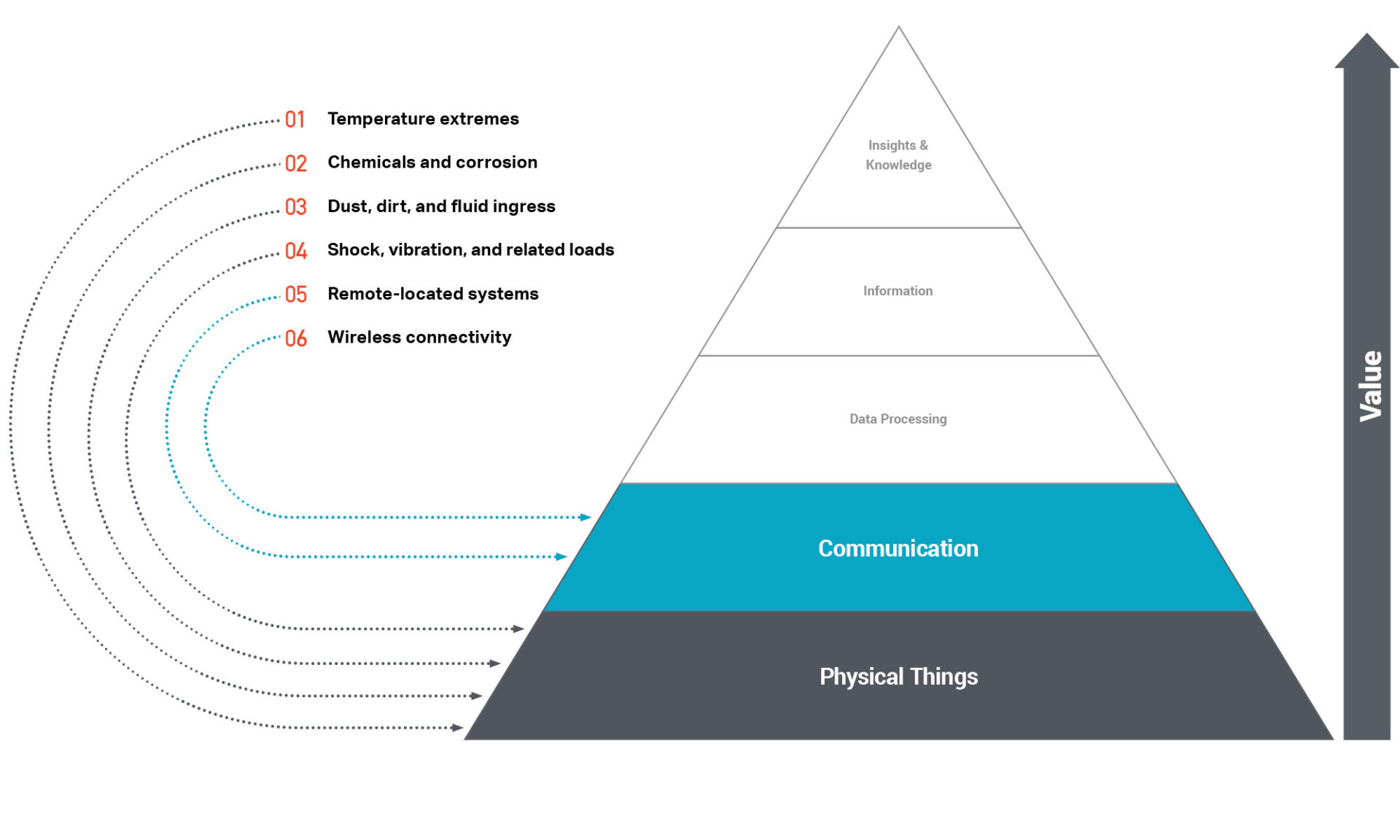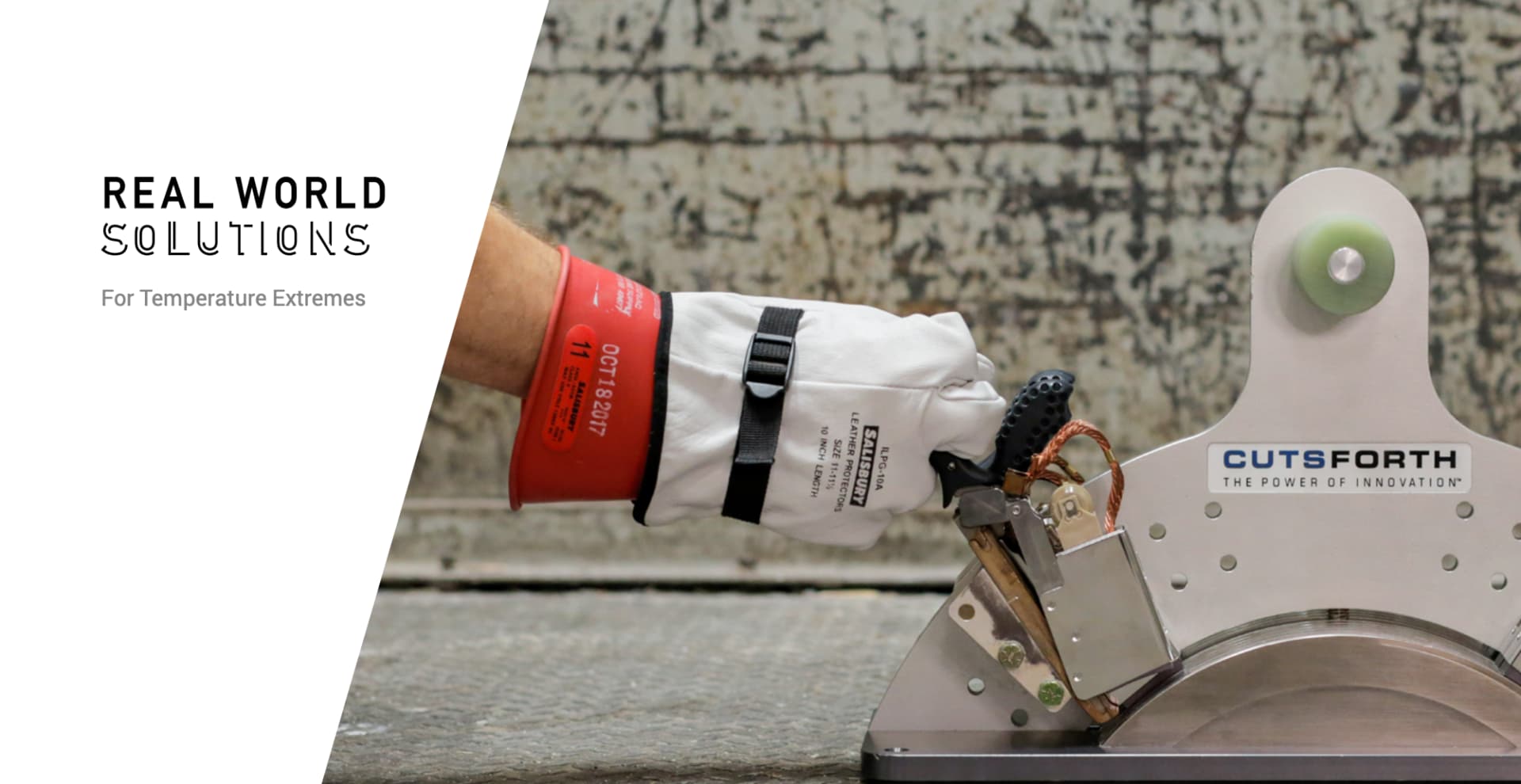Additional contributions to this series made by: Ian Graves, Bret Richmond, & Mike Schaaf

CONDITIONS
High, low, or rapid changes in temperatures can contribute to a harsh environment. Electronic components are typically those most sensitive to temperature, as mechanical components can usually be selected to have a wider operating temperature range. For electronic components, the typical ‘commercial’ temperature range they are rated to operate in is 0°C (32°F) to 45°C (113°F), which is fine for most consumer electronics that are kept inside in ‘friendly’ climate-controlled conditions. However, as soon as systems are required to work in less controlled environments, rated temperature ranges rapidly increase. Typical temperature ratings for automotive components extend to -40°C (-40°F) to 125°C (257°F) to account for the temperature ranges experienced in automotive applications where systems are left unprotected and outside.
Industrial environments are different again, where conditions are often carefully controlled, but may reach temperature extremes that can be more challenging for electronics, resulting in typical specified ‘Industrial’ operating temperature ranges covering -20°C (-4°F) to 85°C (185°F). This could be everything from metal processing and manufacturing equipment to commercial freezers.
Pushing beyond these temperature ranges is possible, but any components specified for extended temperature ranges that cover the full range of -55°C (-67°F)to 125°C (257°F), or extend beyond this range, are export-controlled, due to the potential for military applications.
Understanding the conditions the system will experience is critical to the design process, and must be done thoroughly to set appropriate requirements. Thermal loads can come from many sources, and the temperatures that products may experience could be more extreme than expected if not carefully characterized. Once these are characterized, and requirements are set, the design process can continue innovating for suitable solutions.

DESIGNING SENSORS FOR TEMPERATURE EXTREMES
Three principles can be used to design products for temperature extremes, once you have characterized what the conditions are:
1) Select Materials and Components Rated to Appropriate Temperatures
This is an obvious one, but the subtleties come when you consider the appropriate temperature ranges for the individual components. When the system itself is dissipating power there may be local temperature hot spots related to power dissipation that need to be considered. In addition, not all components or parts of the system will be exposed to external environmental conditions and may be able to be specified for a different temperature range. This is discussed further in the next principle.
2) Protect Materials and Components from Temperatures Outside Their Rated Ranges
If components cannot be rated to meet the temperature requirements, the system could be designed to protect these components from temperature extremes outside their limits. Using passive or active cooling systems to reduce temperatures locally is a strategy used in many electronic devices to pull heat away from the most power-hungry components; a strategy that can be extended to keep specific components cooler than the ambient environment if required.
Protecting against lower temperatures is easy when power is not a challenge, simply dumping power into a heater can increase the temperature locally. This can be more of a challenge in low power applications, where more passive solutions such as increased insulation may be the only feasible options.
To develop these designs you can use a combination of simulation and testing to determine the thermal performance, allowing quick iteration through design options to find the most effective solution.
3) Test Components and Materials for Performance Outside Their Specified Ranges
If it isn’t possible within the constraints of the system and environment to keep components within their rated temperature ranges, then a last resort is to test the performance of components outside of these ranges (specifically in conditions your system is expected to experience). Component ratings require significant testing by the manufacturer, and it may be that they didn’t have the motivation to perform testing to the specific temperatures you are interested in if they are outside normal ranges. Make sure to get information from the vendor and perform your own testing in order to be effective when pushing the limits of the thermal performance of components.

MONITORING POWER PLANT HEALTH WITH INDUSTRIAL IOT
Cutsforth’s innovative EASYchange®Brush Condition Monitoring system utilizes special sensors to measure and send data about the wear and tear of essential generator parts back to the power plant facility’s control room. This is a perfect example of a product facing high-temperature thermal challenges. The sensors needed to be placed close to graphite brushes that were known to operate at elevated temperatures, with reports of brushes glowing red hot in fault conditions.
Due to the high-reliability requirements of this system, it was critical that these sensors wouldn’t fail due to thermal issues. If the thermal conditions went out of the expected range in a failure situation, the sensors could not fail in a way that would contribute to an already dangerous situation.
With little reference data to understand temperature limits, the first step was to characterize the required operating condition. This was done using a thermal camera, in conjunction with near form factor data loggers, which were closely monitored during the few hours they were on the system. The data from these gave a good baseline to work from and helped set requirements for the sensors.
During the design process, simulation was used to inform decisions. One of which was to architect the connection of the sensor to the system in such away as to minimize the high temperatures impacting the electronics within the sensor. Automotive-grade electronic components were also selected to tolerate the significantly elevated temperatures, and high-temperature engineer plastics were used to facilitate radio communication while continuing to be highly temperature tolerant.
Power supply to the sensors was a significant challenge. The temperatures extended well beyond the range normal lithium-ion batteries can tolerate, forcing a move to higher temperature tolerant lithium-metal cells. Careful electronic and firmware design was required to work with these batteries and provide the required product lifetime.
Together, these accomplishments enabled Cutsforth to introduce sensors that monitor generator health and better serve their customers with reliable data to predict maintenance needs.

OPTICAL SENSORS IN COMMERCIAL KITCHENS
Whether it’s a commercial kitchen at a fast food restaurant or your kitchen at home, for connected or IoT devices, kitchens can be some of the harshest environments. A connected device for use in a kitchen may need to withstand the temperatures of a commercial oven, steam, grease accumulation, and cleaning with aggressive chemicals.
For example, consider the prospect of adding machine vision to a commercial conveyor-style pizza oven to confirm pizzas have been made correctly per the order. To accomplish this, one would need a method to take a picture of each pizza traveling through the oven, which could be analyzed with a machine vision algorithm. Incorrectly made pizzas could then be rerouted out of the oven before cooking.
Commercial pizza ovens can exceed temperatures of 800°F, which is significantly higher than electronics or cameras are generally rated. Even a highly exotic cooling solution would be no match for these conditions. The best method for protecting the vision system would be to isolate it from the high temperatures. One way to address this is with a feedthrough, where a glass lens with a low emissivity coating protects the camera by allowing it to reflect as much IR (infrared radiation) as possible and could allow it to be physically separated from the high-heat area.
Additionally, an optical solution might allow for mirrors and lenses to be used in combination to add additional distance between the camera and the pizza. However, precision optics such as these are often very costly and need to be positioned correctly to function properly.

